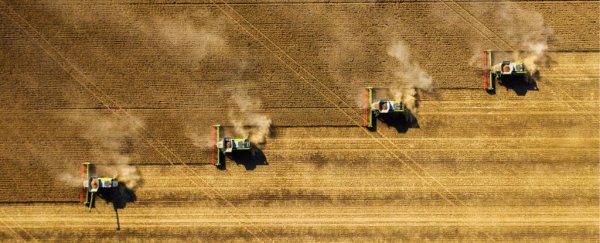
Planting more crops isn't the only way to feed a growing population. Cutting air pollution could go a long way towards increasing crop production while saving precious land and money, according to new research.
If the world cuts the emissions of just one type of air pollutant in half, estimates suggest winter crops could yield about 28 percent more in China and up to 10 percent more in other parts of the world.
The pollutants in question are oxides of nitrogen, a family of invisible, poisonous gasses produced by car exhaust and industrial emissions that include nitrogen dioxide.
Nitrogen oxide emissions are some of the most widely distributed air pollutants in the world, and it's suspected that if plants are exposed to higher levels of these gasses, their leaves can be damaged and their growth stunted, although experts are still figuring out exactly how.
At the same time, nitrogen oxides are also precursors to the formation of ozone and tiny aerosols in the atmosphere, which can dim sunlight and reduce crop productivity in turn.
Last year, research by some of the same authors found that reductions in ozone, particulate matter, nitrogen dioxide, and sulfur dioxide caused a 20 percent increase in corn and soybean yields in the United States between 1999 and 2019.
That's around US$5 billion dollars worth of crops saved each year by reducing just four types of air pollutants.
Nitrogen dioxide is one of the easier pollutants to measure regionally, and directly compare to crop growth. When emitted into the atmosphere, nitrogen dioxide interacts with ultraviolet light in a way easily detected by satellites.
"Nitrogen oxides are invisible to humans, but new satellites have been able to map them with incredibly high precision," explains agricultural ecologist David Lobell from Stanford University.
"Since we can also measure crop production from space, this opened up the chance to rapidly improve our knowledge of how these gasses affect agriculture in different regions."
Comparing nitrogen dioxide emissions in various regions of the world with the greenness of cropland, the team found a consistently negative effect.
The loss of greenery was especially noticeable in China and for wintertime crops like wheat. Using this correlation, researchers estimate that cutting nitrogen dioxide emissions by 50 percent would improve winter crop yields in China by roughly 28 percent. In summer, yields could improve by 16 percent.
In India, researchers predict nitrogen dioxide reductions could increase crop yields by up to 8 percent for winter, and 6 percent for summer. Meanwhile, in western Europe the yields for summer and winter crops could increase by 10 percent.
When yield rates typically fluctuate around a percent every year, the effects of cutting air pollution could be immense for some parts of the world.
"The main take-home from this study is that the agricultural benefits of these actions could be really substantial, enough to help ease the challenge of feeding a growing population," says environmental scientist Jennifer Burney from the University of California San Diego.
We might not yet know how nitrogen oxides directly impact plant growth, but the strong relationship found in the current research suggests air pollution is contributing to crop losses around the world.
The study was published in Science Advances.
No comments:
Post a Comment